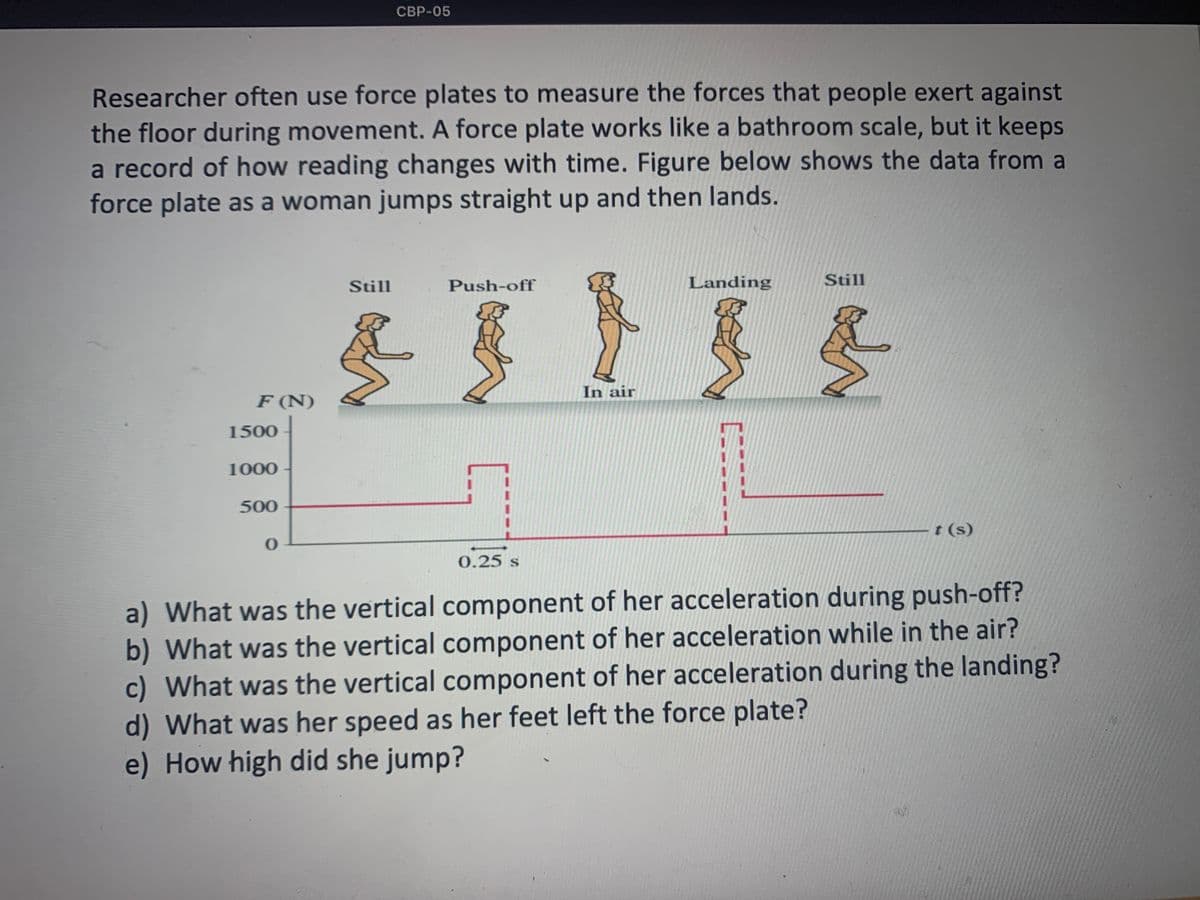Researcher often use force plates to measure the forces that people exert against the floor during movement. A force plate works like a bathroom scale, but it keeps a record of how reading changes with time. Figure below shows the data from a force plate as a woman jumps straight up and then lands. TITE Still Push-off Landing Still In air F (N) 1500 1000 500 t (s) 0.25 s a) What was the vertical component of her acceleration during push-off? b) What was the vertical component of her acceleration while in the air? c) What was the vertical component of her acceleration during the landing? d) What was her speed as her feet left the force plate? e) How high did she jump?
Researcher often use force plates to measure the forces that people exert against the floor during movement. A force plate works like a bathroom scale, but it keeps a record of how reading changes with time. Figure below shows the data from a force plate as a woman jumps straight up and then lands. TITE Still Push-off Landing Still In air F (N) 1500 1000 500 t (s) 0.25 s a) What was the vertical component of her acceleration during push-off? b) What was the vertical component of her acceleration while in the air? c) What was the vertical component of her acceleration during the landing? d) What was her speed as her feet left the force plate? e) How high did she jump?
College Physics
11th Edition
ISBN:9781305952300
Author:Raymond A. Serway, Chris Vuille
Publisher:Raymond A. Serway, Chris Vuille
Chapter1: Units, Trigonometry. And Vectors
Section: Chapter Questions
Problem 1CQ: Estimate the order of magnitude of the length, in meters, of each of the following; (a) a mouse, (b)...
Related questions
Question

Transcribed Image Text:СВР-05
Researcher often use force plates to measure the forces that people exert against
the floor during movement. A force plate works like a bathroom scale, but it keeps
a record of how reading changes with time. Figure below shows the data from a
force plate as a woman jumps straight up and then lands.
Still
Push-off
Landing
Still
In air
F (N)
1500
1000
500
t (s)
0.25 s
a) What was the vertical component of her acceleration during push-off?
b) What was the vertical component of her acceleration while in the air?
c) What was the vertical component of her acceleration during the landing?
d) What was her speed as her feet left the force plate?
e) How high did she jump?
Expert Solution
This question has been solved!
Explore an expertly crafted, step-by-step solution for a thorough understanding of key concepts.
This is a popular solution!
Trending now
This is a popular solution!
Step by step
Solved in 3 steps with 3 images

Recommended textbooks for you

College Physics
Physics
ISBN:
9781305952300
Author:
Raymond A. Serway, Chris Vuille
Publisher:
Cengage Learning

University Physics (14th Edition)
Physics
ISBN:
9780133969290
Author:
Hugh D. Young, Roger A. Freedman
Publisher:
PEARSON

Introduction To Quantum Mechanics
Physics
ISBN:
9781107189638
Author:
Griffiths, David J., Schroeter, Darrell F.
Publisher:
Cambridge University Press

College Physics
Physics
ISBN:
9781305952300
Author:
Raymond A. Serway, Chris Vuille
Publisher:
Cengage Learning

University Physics (14th Edition)
Physics
ISBN:
9780133969290
Author:
Hugh D. Young, Roger A. Freedman
Publisher:
PEARSON

Introduction To Quantum Mechanics
Physics
ISBN:
9781107189638
Author:
Griffiths, David J., Schroeter, Darrell F.
Publisher:
Cambridge University Press

Physics for Scientists and Engineers
Physics
ISBN:
9781337553278
Author:
Raymond A. Serway, John W. Jewett
Publisher:
Cengage Learning

Lecture- Tutorials for Introductory Astronomy
Physics
ISBN:
9780321820464
Author:
Edward E. Prather, Tim P. Slater, Jeff P. Adams, Gina Brissenden
Publisher:
Addison-Wesley

College Physics: A Strategic Approach (4th Editio…
Physics
ISBN:
9780134609034
Author:
Randall D. Knight (Professor Emeritus), Brian Jones, Stuart Field
Publisher:
PEARSON